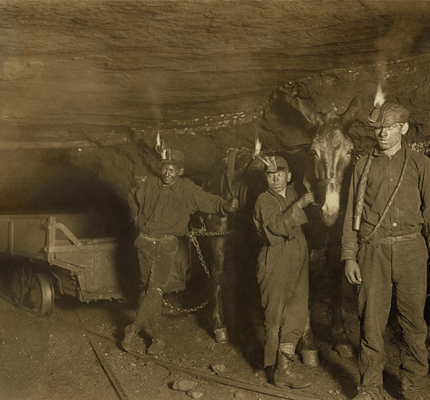
The Second Battle of Blair Mountain
In the 1910s and 1920s, there were numerous conflicts between miners and mining companies in the United States. Many mine workers worked and lived in company towns, where workers were paid low wages in company currency that was accepted only at the company store. The United Mine Workers (UMW) union attempted to organize workers in West Virginia but faced heavy opposition from mining companies.
In May 1920, a brutal conflict called the Matewan Massacre resulted in the deaths of both miners and private guards hired by a mine company in Matewan, West Virginia. About a year later, Matewan’s pro-union sheriff was murdered. The murder served as a catalyst for an uprising of unionized miners and an August 1921 confrontation between unionized miners and mine guards in West Virginia, a conflict that became known as the Battle of Blair Mountain.
During the Battle of Blair Mountain, unionized workers from Matewan and southern West Virginia attempted to occupy non-union mines in nearby Logan County to protest mining companies’ treatment of workers. The path from Matewan to the mines in Logan County required the miners to pass over Blair Mountain, where they met resistance from state police and other anti-union individuals. The miners quickly surrendered after federal troops became involved but faced legal consequences from state and local governments. In addition, mining companies accused the unionized and pro-union workers of being “un-American” and violent.
Coal mining has continued to be part of life in West Virginia, but coal mining practices have changed in recent decades. Mountaintop Removal (MTR) is a mining practice wherein the land above coal deposits is removed, so that the coal can be more easily mined. MTR has had tremendous repercussions for both the environment and the health of people in West Virginia. Activists in West Virginia who have fought against MTR have been subjected to violence at the hands of others, such as being run off the road while driving.
In a new article published in NCA’s Communication and Critical/Cultural Studies, Matthew S. Richards uses the rhetorical concept of kairos to examine the implications and relevance of the Battle of Blair Mountain for current West Virginia conflicts over MTR.
Kairos is a rhetorical concept that refers generally to timing of speech and the optimal moment of persuasion. In this context, Richards argues that kairos can draw attention to the relationship between two points in time through kairic folding, “when important rhetorical elements of one event come to bear in significant ways on another.”
On the 90th anniversary of the Battle of Blair Mountain in 2011, CNN released the documentary “The Battle for Blair Mountain: Working in America,” which included an online educator and parent guide. However, activists against MTR criticized CNN for parroting industry lines that pit environmentalism against jobs. Harvard Ayers, a professor and activist, wrote in the Charleston Gazette that CNN missed the opportunity to focus on the systemic violence of the coal industry against the people and environment in Appalachia: “Mountaintop removal actually costs coal jobs, and the industry prefers it to deep mining for one reason—it’s cheap, as explosives and giant machines do most of the work. Essentially, every mountaintop removal job eliminates as many as two underground mining jobs. It all boils down to maximizing profits.” Richards argues that Ayers’ argument is an example of a kairic fold because it highlights the connection between the struggle against mining companies in the early 20th century and today’s struggle against MTR.
Activist Chuck Belmont Keeney similarly draws connections between the Battle of Blair Mountain and MTR. In Think Progress, Keeney wrote, “Behold the road to Blair Mountain, where another civil war looms in the hills of Appalachia. Ninety years before, 10,000 armed coal miners marched to secure a decent living and to be treated as human beings… Today there is a Second Battle of Blair Mountain.” Richards argues that Keeney framed the activists as heroes and victims of corporate violence and further that Keeney “positioned miners and activists similarly against destructive forces of corporate/systemic violence.” Thus, according to Richards, Keeney used kairic folding to draw connections between the violence experienced by the miners in 1921 and the violent destruction of historical and environmentally significant mountaintops, such as Blair Mountain, through MTR.
In 2011, activists held a concert and march to commemorate the anniversary of the Battle of Blair Mountain and protest MTR. The activists paid tribute to the miners by marching as the miners had in 1921. Richards argues that the activists used kairic folding to highlight the connection between the miners’ struggle against corporate power and the activists’ struggle against corporate power. The activists were not only marching against MTR, but were marching to protect Blair Mountain, a historical site of U.S. labor history, from MTR. According to Richards, the activists also drew comparisons between the violence that mining companies encouraged among miners of different races and the way that the mining companies sought “to play the miners against the citizens who want to protect their communities and themselves from being poisoned and afflicted with cancer due to mountaintop removal operations.”
Richards argues, through these and other examples, that activists used the anniversary to try to protect Blair Mountain from MTR by establishing the activists as continuing a fight against corporate power that dates back to the Battle of Blair Mountain. According to Richards, “Folding the two moments together becomes a way to create a political lineage for these contemporary activists that ideally taps into the positive and romantic ethos of rebellious miners fighting evil coal operators.”
Richards also argues that the kairic fold demonstrates the influence of violence with regard to the history of how Appalachia is understood more broadly. Violence shaped the development of Appalachia as a cultural outlier and a sacrifice zone, a place where workers work to provide resources and profits for interests outside the region. The activists also drew on this history, demonstrating that class implicitly influences rhetorical choices.


